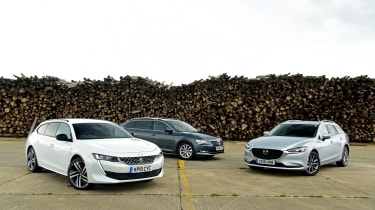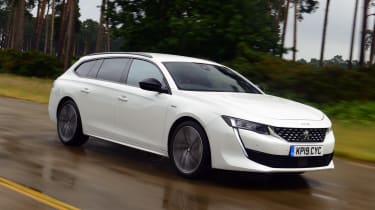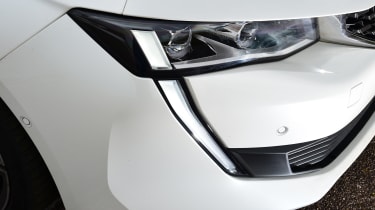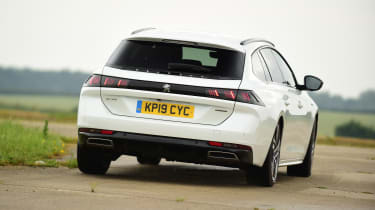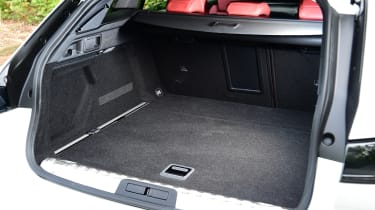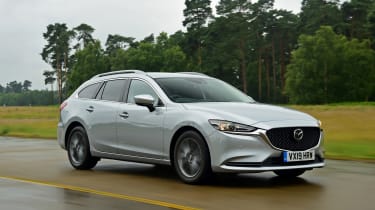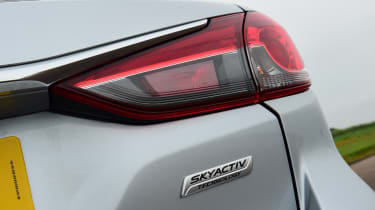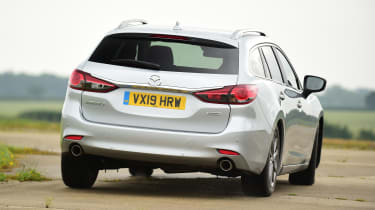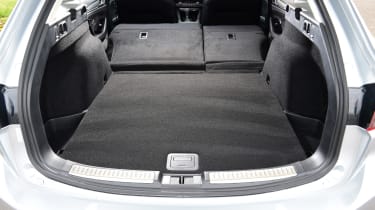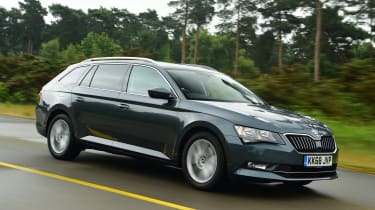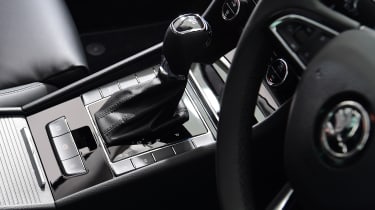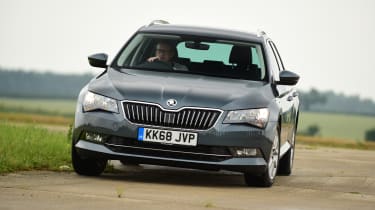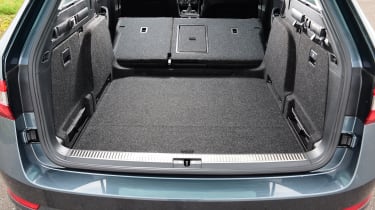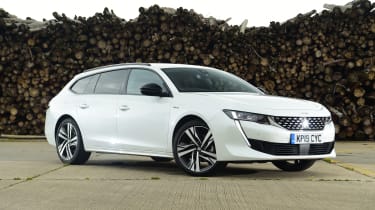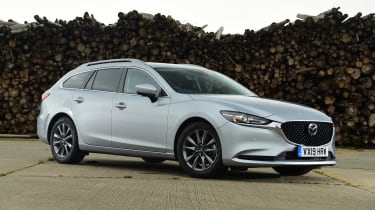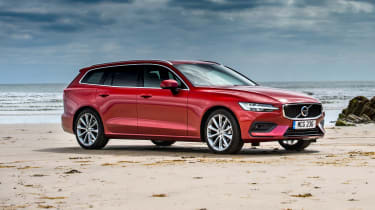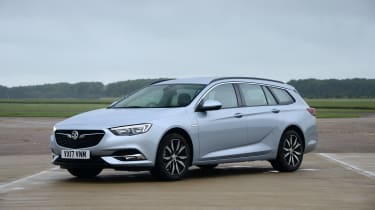Peugeot 508 SW vs Mazda 6 Tourer vs Skoda Superb Estate
We pitch the new upmarket Peugeot 508 SW against the Mazda 6 Tourer and Skoda Superb Estate
Practicality comes in many forms. SUVs have captured this most recently with the trend that’s seeing more people ditch family estates for higher-riding off-roaders. But despite the stronger profit margins in the SUV class, brands haven’t abandoned the big estate yet.
Peugeot is proving this with the release of its 508 SW, a stylish, swoopy wagon that packs practicality and, increasingly for the French brand, a more premium image and feel. But while Peugeot might be targeting German rivals in some areas, when it comes to price, the 508 SW still lines up against the likes of the Mazda 6 Tourer and Skoda Superb Estate.
• Best estate cars to buy 2019
These are workaday wagons that also offer a more car-like experience as an alternative to those brands’ respective SUVs. But which is our pick? We’re putting these three diesel models to the test to find out which one best combines all the attributes a great estate needs
Peugeot 508 SW
| Model: | Peugeot 508 SW 1.5 BlueHDi 130 EAT8 GT Line |
| Price: | £31,495 |
| Engine: | 1.5-litre 4cyl turbo, 129bhp |
| 0-60mph: | 11.1 seconds |
| Test economy: | 46.0mpg/10.1mpl |
| CO2: | 104g/km |
| Annual road tax: | £145 |
In GT Line trim the 508 SW might be the most expensive car here, at £31,495 for this BlueHDi 130 EAT8 model, but it gets lots of equipment and PCP finance could make it even more affordable. But it’ll need to have the talent to back up its looks.
More reviews
Car group tests
- Peugeot 408 vs Cupra Formentor: 2023 twin test review
- Peugeot 508 SW PSE vs BMW 330e Touring: 2022 twin test review
- Genesis G70 Shooting Brake vs Peugeot 508 SW: 2022 twin test review
- Peugeot 508 Hybrid vs Skoda Superb iV
In-depth reviews
Long-term tests
Road tests
Used car tests
Design & engineering
As with the 508 Fastback, this SW estate is based on Peugeot’s EMP2 platform (so is up to 70kg lighter than its predecessor), which is a modular architecture that can be scaled up and down, and accept many different powertrains, so a plug-in hybrid will appear in the future.
For now, diesel will still be a big-seller in this class, so we’ve got the 1.5-litre four-cylinder turbodiesel which produces 129bhp and 300Nm of torque. While the latter figure is the one that characterises most diesels, the Peugeot offers 80Nm less than the Mazda and is 40Nm down on the Skoda, but then it’s lighter than both its rivals, at 1,430kg. This lower kerbweight and lesser engine output means the 508 does have efficiency on its side, though.
You can add kit and quality to that list of attributes, too, because GT Line trim offers nav, a digital dash, smartphone connectivity, lots of protective safety systems, heated seats, all-round parking sensors, a rear-view camera and keyless operation. The only option you might want to add is leather upholstery; you get ‘leather-effect’ trim, but for £1,550 you can add real hide with electric adjustability and a massage function for the front seats.
The cabin design is interesting, cocooning you but not sacrificing practicality all that much. However, the i-Cockpit layout might be a bit more divisive. You’re meant to look over the small steering to the digital dials, rather than through it, but we find this relationship a little awkward. At least cabin materials are mostly good, with soft-touch textures on the dash and higher up on the doors.
• Best used estate cars to buy now
The estate’s interior matches the engineering underneath, then. But it’s worth pointing out that the £1,000 adaptive dampers for the MacPherson- strut front and multi-link rear suspension aren’t available on this 1.5 BlueHDi 130 model.
Driving
The 508 SW is relaxed. Even without adaptive dampers, the fairly sophisticated suspension controls body movement with a decent balance between comfort and cornering ability.
On our car’s 19-inch alloys it does tend to thump a little more than the Mazda, but the Skoda isn’t immune from this trait, so the 508 doesn’t disgrace itself. It feels agile enough for a big car, too, helped by that weight-saving compared with its rivals, plus the i-Cockpit set-up’s small steering wheel and fairly fast rack, which means the nose responds quickly.
There’s decent grip, although the light steering has zero feel, and, in this estate, which sits lower when compared with some of the brand’s SUVs, the small wheel actually doesn’t make it feel nervous or like it rolls too much.
The engine is smooth if you’re gentle with it. If you don’t rev it too hard and use the torque, which also stops the gearbox kicking down too much, it’s easy to make fairly swift progress, but it’s not on par with its more powerful rivals. The 508 took 11.1 seconds to accelerate from 0-60mph, and although it has more gear ratios to cover a similar speed range, the 508 still feels the most sluggish car.
At least the EAT8 transmission is smooth. It’s not quick, but is slushy when swapping ratios, although occasionally it does get caught out and is hesitant in responding to the throttle.
Practicality
The 508 SW’s 530-litre boot is some way behind the Skoda’s 660-litre load bay, but it has the measure of the Mazda by eight litres. So the Peugeot has enough practicality, and you can boost this by opting for the £400 powered tailgate, if you feel the need.
The swoopy roofline means there’s not as much headroom in the rear, but legroom is good; it’s a match for the Mazda and a little less than the Skoda. In the front, the high dashboard line and centre console give a nice, wraparound feel, but they don’t impact practicality or space too much.
There could be a few more storage options to match the Skoda’s, but it has just enough space for drinks or phones. Just like in the other cars, the big bin between the front seats is a good place to dump other items. However, it’s worth mentioning that the USB ports are tucked away under the centre console and are a pain to access.
Ownership
Lane-keep assist, autonomous braking and full-LED headlights, plus six airbags, and blind spot assist are all standard, which helped the 508 earn a five-star Euro NCAP rating.
• Best family cars to buy 2019
Compared with the two brands here, Peugeot’s result in our Driver Power 2019 survey wasn’t as good, with a mid-table placing of 12th in the car makers’ chart. Both rivals finished towards the top, with Mazda finishing fourth and Skoda fifth.
Running costs
These cars will be popular with business users, so despite being pricier, the Peugeot’s low 104g/km CO2 emissions mean it will be cheaper for higher-rate earners, with an annual Benefit-in-Kind (BiK) cost of £3,502.
Go for the 117g/km Skoda and this rises to £3,737 because it sits in the 31 per cent BiK band, while the much more polluting 134g/km Mazda (34 per cent bracket) comes in at £3,959. There’s £457 per year between the cheapest and most expensive here.
Testers' Notes: “The price you pay for style is that rear visibility in the 508 SW is pretty poor, due to that shallow back window that creates the sleek look. It’s a good job parking sensors and a camera are standard.”
Mazda 6 Tourer
| Model: | Mazda 6 Tourer 2.2 Skyactiv-D SE-L Nav+ Auto |
| Price: | £29,695 |
| Engine: | 2.2-litre 4cyl turbo, 148bhp |
| 0-60mph | 10.1 seconds |
| Test economy: | 44.3mpg/9.7mpl |
| CO2: | 134g/km |
| Annual road tax: | £145 |
As with Peugeot and Skoda, Mazda is one manufacturer that’s kept a family estate option in its range, so the 6 Tourer has benefited from years of development. Does that mean it’s a better car than its French and Czech rivals here, though? We’re testing a £29,695 entry-level 2.2 turbodiesel automatic in SE-L Nav+ trim to find out.
Design & engineering
Mazda's 6 Tourer is known for being one of the best estate cars to drive, and that’s thanks to the engineering beneath its fairly attractively styled body.
The car uses Mazda’s Skyactiv platform technology, which the manufacturer claims uses lightweight materials in strategic places to keep weight down and boost agility. However, it’s the heaviest car here, at 1,626kg. But at least the bodyshell is strong, which is good for safety in a family car such as this.
There’s also a good level of power and torque on offer from the 2.2-litre four-cylinder turbodiesel engine, with 148bhp to match the Skoda and the most torque here, at 380Nm.
Suspension control comes courtesy of MacPherson struts at the front and a multi-link set-up at the rear, the same as the Peugeot.
Despite a revamp last year which aimed at keeping the 6 fresh, a good proportion of the cabin still harks back to the previous facelifted car that was launched in 2015. This means the interior is perfectly adequate, but the quality and the design aren’t quite up to the same level as its two rivals’ here. However, the driving position is by far the best of this trio, which means comfort is good.
Back to the cabin, and the materials don’t feel quite as expensive as in either the high-spec Peugeot or Skoda. On that point, while SE-L Nav+ is the cheapest of the three cars, at £29,695, it loses out on some kit compared with the 508 SW or the Superb.
• Best used family cars to buy
You get sat-nav, DAB radio, connected services, all-round parking sensors, good safety kit and LED lights like the 508. You must pay extra for Android Auto and Apple CarPlay, while features such as leather upholstery, heated seats and keyless operation aren’t available on SE-L Nav+, even as options.
Upgrading to SE-L Nav+ Lux trim would in theory get you these extras, but that’s actually a futile move, because that model doesn’t come with an automatic transmission in conjunction with this diesel engine to match the rivals’ powertrains in this test.
Driving
The Mazda’s steering is great. It’s weighty, but not too heavy, and the speed of the set-up is right for the level of grip the car generates, which is a surprising amount for a family estate.
With taut body control, it’s a nice car to drive. It feels responsive, while the engine offers a good level of punch to match the chassis, as our tests showed.
It took a competitive 10.1 seconds to sprint from 0-60mph, while its in-gear times were equally strong. The engine feels as grunty as the Superb’s and the motor is smooth and fairly subdued, thanks to clever dampers in the pistons that help keep the usual diesel grumble to a distant hum. It’s much better than the Skoda. Where it loses out to its rivals is with the gearbox. The six-speed auto goes about its business unobtrusively, but is slow to change, slurring upshifts but taking a while to complete them.
Otherwise, the body control doesn’t adversely affect the ride comfort and the 6 is comfortable on the motorway. It’s nice around town, too, with less harsh reactions to bumps that could cause a resonating thump. Thank the smaller alloys for that.
Practicality
At 522 litres, the Mazda has the smallest load bay of this trio, but it’s only eight litres down on the Peugeot, so there’s still enough space for most trips with the family’s luggage. It’s just that on occasions such as holidays or journeys with lots of items to carry that the Skoda will offer more flexibility.
This is true inside the cabin as well, because the 6 isn’t as spacious as the Superb. It feels roomier than the tighter Peugeot, but then the interior quality isn’t as good and the car isn’t quite as stylish, either.
There certainly aren’t as many thoughtful interior touches as in the Superb, but acceptable storage means the Mazda is a versatile estate car that’s not without its positives. It is the only one of these three models that isn’t available with a powered tailgate.
Ownership
Mazda beat Skoda in our Driver Power 2019 satisfaction survey, taking fourth place overall, which is a great result. The brand was praised for its engine and gearboxes, ride and handling, plus build quality and reliability.
You can also add safety to its list of attributes, because the Mazda is the only car here to get lane- keep assist, blind-spot warning and autonomous braking as standard. Adaptive cruise is included, too, so the Mazda gets a five-star Euro NCAP rating.
All three competitors are covered by a three-year/60,000-mile manufacturer’s warranty.
Running costs
As with CO2 and company car costs, fuel economy will be an important factor in this class. The Mazda managed 44.3mpg, which means annual fuel bills of £1,654.
This compared with 46mpg for the Peugeot, and yearly fuel costs of £1,593, while the Skoda returned 51.4mpg, so you’ll pay £1,425 at the pumps for diesel over 12 months.
Insurance works out at £445, £473 and £470 for the Mazda, Peugeot and Skoda respectively, so there’s not much between them.
Testers notes: “As with the Skoda Superb, we’d actually go for a manual Mazda, because the gearbox is great and better than the automatic alternative, plus you get a wider choice of trims.”
Skoda Superb Estate
| Model: | Skoda Superb Estate 2.0 TDI 150 DSG SE L Executive |
| Price: | £30,405 |
| Engine: | 2.0-litre 4cyl turbo, 148bhp |
| 0-60mph | 10.0 seconds |
| Test economy: | 51.4mpg/11.3mpl |
| CO2: | 117g/km |
| Annual road tax: | £145 |
The Skoda Superb Estate has been a firm Auto Express favourite for years. However, with the advent of newer, plusher family wagons that are more premium and pushing upmarket (our pictures show an SE Tech) is this £30,405 2.0 TDI 150 DSG SE L Executive model a worthy rival?
Design & engineering
Not unlike Peugeot and its EMP2 architecture, the VW Group – and, by association, Skoda – was the first really big manufacturer to benefit from modern platform sharing. That means the Superb Estate, released in 2015, is based on the MQB underpinnings.
It’s one of the largest cars to use this platform, which was designed for front-engined models, and here the 2.0-litre turbodiesel pumps out 148bhp and 340Nm of torque. The latter output in particular is much stronger compared with the Peugeot’s. But then, the Skoda is also heavier, at 1,507kg.
Besides, practicality is one of the biggest areas of importance in an estate, so performance might take a back seat for a large group of buyers. Here the Skoda excels. It’s the longest, widest and tallest car of this trio, plus it has the longest wheelbase. This brings benefits when it comes to space, as we’ll see.
The cabin is on par with the Peugeot’s for quality but not for design. The materials are plush – soft where you want them and mostly hardwearing where you need them – but the interior styling focuses more on function than form, whereas the 508 seems to better balance these two factors. The Superb gets plenty of equipment, though.
With front and rear parking sensors, autonomous braking, blind-spot monitoring, adaptive cruise, heated leather seats, keyless operation, power tailgate, sat-nav and strong phone tech, it just shades the 508 for kit, while it’s also £1,090 cheaper.
Driving
The Skoda isn’t as smooth or refined as the Peugeot. That’s due partly to the engine and partly the gearbox. The former offers a lot of performance thanks to its higher output; on test, 0-60mph took 10 seconds compared with 11.1 in the Peugeot, for example, while it was stronger in-gear, too. In fifth it completed the 50-70mph sprint in 6.7 seconds, compared with 7.2 for the 508. But it’s definitely a noisier, less refined motor. Once warm, the Peugeot’s unit settles down, whereas the Skoda’s grumbles more under load.
The drivability of the DSG box isn’t bad, though. Occasionally it’s a little abrupt when manoeuvring, but otherwise it matches the 508’s eight-speed auto for smoothness and response. The shifts are quicker, yet it blends gears just as well when accelerating.
It also steers more sweetly than the 508, thanks to a more conventionally sized wheel, but the Skoda still can’t match the Mazda for involvement. The ride is a little inconsistent, too; it’s mostly as comfortable as the Peugeot’s, yet suffers the same harsh reactions to big bumps or cracks as the 508, the wheels rebounding with a thud. It’s acceptable, but the Superb is a sharper car to drive on twisty roads.
These models will spend plenty of time on the motorway, so refinement and ride comfort are big issues. The Peugeot has a slightly floatier gait to the way it covers ground at higher speed, but the Skoda isn’t uncomfortable. It’s calmer and quieter on bumpy back roads.
Practicality
The 660-litre boot is cavernous, making the Skoda far more practical than its competitors when it comes to load space. But thanks to the dimensions mentioned before, especially the wheelbase length, there’s an incredible level of passenger room on offer as well.
Rear-seat legroom is excellent and shades the Peugeot’s. The taller Skoda’s squarer roofline means there’s plenty of headroom, too. The Mazda sits somewhere in between the two cars, erring slightly more towards the Skoda’s level of space.
The front of the cabin is also roomy. It’s less cocooning than the 508’s, so it doesn’t feel quite as cosseting, but it does mean there’s plenty of storage.
Ownership
Standard safety kit is strong. While the Superb gets autonomous braking and blind-spot assist as standard, as with the Mazda, it gets adaptive cruise control, too. This is a £400 option on the 508, but then the Peugeot comes with a reversing camera, which costs £355 on the Skoda and isn’t available on the Mazda SE-L Nav+.
You can add lane-keep assist to the Skoda for £495, but even without it the Superb scored a full five-star Euro NCAP safety rating. The brand also finished fifth in our Driver Power 2019 manufacturers’ poll – one behind Mazda and seven ahead of Peugeot.
• Driver Power: Best cars to own 2019
Skoda’s £342 two-year servicing pack means it’ll also be the more cost-effective car to keep on the road. Peugeot’s three-year pack costs £14 per month, while three services on the 6 will set you back £499.
Running costs
The Skoda can’t quite match the Peugeot’s company car tax costs, and neither can it equal the French model’s predicted residual values, according to our experts. The Superb will retain 42.8 per cent of its original price, which means it’ll shed £17,404.
The Peugeot is estimated to retain 45 per cent of its list price, but because it’s a bit more expensive to buy, it’ll lose £17,319, bringing it closer to the Skoda.
Meanwhile, the Mazda 6 is expected to hold on to 38.1 per cent, which equates to depreciation of £18,369, the highest of this trio. This means the cars will be worth £13,001, £14,176 and £11,326 respectively after three years or 36,000 miles.
Testers’ notes: “A facelifted Superb will go on sale later this year with a plug-in hybrid version. This could be a good alternative to a diesel and will offer even lower Benefit-in-Kind company car tax bills.”
Verdict
First place: Skoda Superb Estate
It's not as premium as the Peugeot 508 SW, but the Superb Estate is extremely well equipped and will cost roughly the same to run. It’s the practicality, performance and the flexibility that the blend of these two attributes brings that just edges the Skoda ahead of the slightly more comfortable 508 SW, even if the Superb is better to drive.
It’s also cheaper and boasts a better infotainment system, too.
Second place: Peugeot 508 SW
The 508 SW proves how far Peugeot has come. It’s an attractive estate that offers genuine usability with some great technology and a nice cabin; the Peugeot straddles the line between mainstream and premium, but when it comes to estate-car attributes, the Skoda just edges it. Pricier GT Line trim gets plenty of kit and the car drives well enough, offering a little more comfort and refinement than the Superb.
Third place: Mazda 6 Tourer
It's the most affordable model in this test, but the 6 Tourer loses out here because it has the least boot space, the highest CO2 emissions and therefore the highest company car tax costs, plus the worst infotainment. There’s also less standard equipment on offer and you can’t upgrade as much. It’s still a solid offering, but by the standards set by its rivals here, the Mazda isn’t as well rounded a package.
Also consider...
Volvo V60
Model: Volvo V60 D3 auto Momentum PlusPrice: £35,865Engine: 2.0-litre 4cyl, 148bhp
Peugeot is targeting more premium models, so it’s the likes of the Volvo V60 it has to beat. In entry-level Momentum Plus spec, it’s pricier and offers one litre less boot volume, but it’s still a great estate that comes loaded with equipment.
Vauxhall Insignia Sports Tourer
Model: Vauxhall Insignia Sports Tourer 1.6D AutoPrice: £30,555Engine: 1.6-litre 4cyl, 134bhp
For around £1,000 less than the Peugeot, you could go for a Vauxhall Insignia Sports Tourer with an automatic gearbox, which boasts slightly more power, 30 litres more boot space and, in top-spec Elite Nav trim, loads of kit. It’s great value.
Figures
| Skoda Superb Estate 2.0 TDI 150 DSG SE L Executive | Peugeot 508 SW 1.5 BlueHDi 130 EAT8 GT Line | Mazda 6 Tourer 2.2 Skyactiv-D SE-L Nav+ Auto | |
| On the road price/total as tested | £30,405/£30,405 | £31,495/£37,860 | £29,695/£30,255 |
| Residual value (after 3yrs/36,000) | £13,001/42.8% | £14,176/45.0% | £11,326/38.1% |
| Depreciation | £17,404 | £17,319 | £18,369 |
| Annual tax liability std/higher rate | £1,869/£3,737 | £1,751/£3,502 | £1,979/£3,959 |
| Annual fuel cost (12k/20k miles) | £1,425/£2,376 | £1,593/£2,654 | £1,654/£ 2,756 |
| Insurance group/quote/VED | 20/£470/£140 | 24/£473/£140 | 25/£445/£140 |
| Cost of 1st/2nd/3rd service | £342 (2yrs) | £14 per month (3yrs) | £499 (3yrs) |
| Length/wheelbase | 4,856/2,841mm | 4,778/2,793mm | 4,805/2,750mm |
| Height/width | 1,477/1,864mm | 1,420/1,859mm | 1,475/1,840mm |
| Engine | 4cyl in-line/1,968cc | 4cyl in-line/1,499cc | 4cyl in-line/2,191cc |
| Peak power/revs | 148/3,500 bhp/rpm | 129/3,750 bhp/rpm | 148/4,500 bhp/rpm |
| Peak torque/revs | 340/1,750 Nm/rpm | 300/1,750 Nm/rpm | 380/1,800 Nm/rpm |
| Transmission | 7-speed DSG/fwd | 8-speed auto/fwd | 6-speed auto/fwd |
| Fuel tank capacity/spare wheel | 66 litres/£150 | 55 litres/yes | 62 litres/repair kit |
| Boot capacity (seats up/down) | 660/1,950 litres | 530/1,780 litres | 522/1,664 litres |
| Kerbweight/payload/towing weight | 1,507/674/2,200kg | 1,430/593/1,500kg | 1,626/592/1,600kg |
| Turning circle | 11.1 metres | 10.8 metres | 11.8 metres |
| Basic warranty/recovery | 3yrs (60,000)/3yrs | 3yrs (60,000)/1yr | 3yrs (60,000)/3yrs |
| Driver Power manufacturer/dealer pos. | 5th/8th* | 12th/17th* | 4th/24th* |
| NCAP: Adult/child/ped./assist/stars | 86/86/71/76/5 (2015) | 96/86/71/79/5 (2018) | 95/91/66/73/5 (2018) |
| 0-60/30-70mph | 10.0/8.8 secs | 11.1/10.5 secs | 10.1/9.8 secs |
| 30-50mph in 3rd/4th | 3.1/4.7 secs | 4.1/5.3 secs | 3.5/4.7 secs |
| 50-70mph in 5th/6th/7th/8th | 6.7/9.6/16.3 secs | 7.2/8.7/12.0/20.0 secs | 7.5/9.3 secs/N/A/N/A |
| Top speed/rpm at 70mph | 130mph/1,600rpm | 129mph/1,700rpm | 126mph/2,000rpm |
| Braking 70-0/60-0/30-0mph | 55.2/39.2/11.1m | 55.4/40.0/11.5m | 53.9/41.1/11.1m |
| Noise outside/idle/30/70mph | 76/49/61/63dB | 74/47/61/63dB | 74/48/62/63dB |
| Auto Express econ. (mpl/mpl)/range | 51.4/11.3/746 miles | 46.0/10.1/557 miles | 44.3/9.7/604 miles |
| Govt combined (WLTP) | 47.1-49.6mpg | 51.4-58.6mpg | 47.1mpg |
| Govt combined (WLTP) | 10.4-10.9mpl | 11.3-12.9mpl | 10.4mpl |
| Actual/claimed CO2/tax bracket | 147/117g/km/31% | 165/104g/km/28% | 171/134g/km/34% |
| Airbags/Isofix/park sensors/camera | Seven/yes/F&R/£355 | Six/yes/F&R/yes | Six/yes/F&R/no |
| Auto box/lane-keep/blindspot/AEB | Yes/£495**/yes/yes | Yes/yes/yes/yes | Yes/yes/yes/yes |
| Clim/cruise ctrl/leather/heated seats | Yes/adaptive/yes/yes | Yes/yes/£1,550**/yes | Yes/adaptive/no/no |
| Met paint/LEDs/keyless/pwr tailgate | £595/no/yes/yes | £575/yes/yes/£400 | £560/yes/no/no |
| Nav/digi dash/DAB/connected services | Yes/£450/yes/yes | Yes/yes/yes/yes | Yes/no/yes/yes |
| Wireless charge/CarPlay/Android Auto | No/yes/yes | Yes/yes/yes | No/£110**/£110** |
